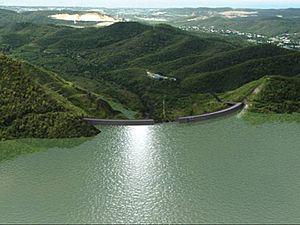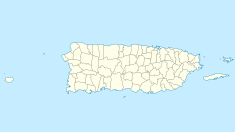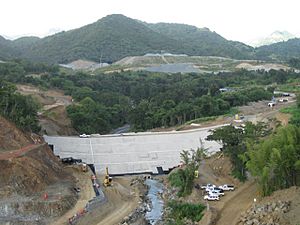Portugués Dam facts for kids
Quick facts for kids Portugués Dam |
|
|---|---|

Artistic rendering of Portugues Dam
|
|
|
Location of the Portugues Dam in Puerto Rico
|
|
| Official name | Represa Portugués |
| Location | Tibes, Ponce, PR |
| Coordinates | 18°3′44″N 66°37′58″W / 18.06222°N 66.63278°W |
| Purpose | Flood control |
| Status | Operational. |
| Construction began | October 2008 |
| Opening date | February 2014, operational in 2015 |
| Construction cost | $750 million USD |
| Owner(s) | Government of Puerto Rico |
| Operator(s) | USACE |
| Dam and spillways | |
| Type of dam | roller-compacted concrete thick arch dam |
| Impounds | Portugues River |
| Height | 220 feet (67 m) |
| Length | 1,230 feet (370 m) |
| Width (crest) | 35 feet (11 m) |
| Width (base) | 110 feet (34 m) |
| Dam volume | 368,000 cubic yards (281,000 m3) |
| Reservoir | |
| Creates | Portugues Reservoir |
| Total capacity | 392,040 cubic feet (11,101 m3) |
| Surface area | 215 acres (87 ha) |
| Pablo Vázquez Ruiz, head project engineer | |
The Portugués Dam (which means Represa Portugués in Spanish) is a special type of dam. It's built using roller-compacted concrete and has a thick arch dam shape. You can find it on the Portugués River, about three miles (5 km) northwest of the city of Ponce, in an area called Tibes.
Building the dam started in April 2008. The U.S. Army Corps of Engineers hired a Spanish company called Dragados USA to build it. Their main goal for the dam is to control floods. It helps protect about 40,000 people and over 13,000 homes from flooding.
This dam is the last part of a big project to protect the Portugués and Bucana rivers from floods. It's also the first dam of its kind built by the U.S. Army Corps of Engineers in the United States or the Caribbean. The total cost was about $375 million. The U.S. Government paid for 75% of it, and the Government of Puerto Rico paid for 25%. The dam was finished in December 2013 and officially opened on February 5, 2014. It became fully operational in early 2015.
Contents
Building the Dam: A Look Back
The idea for a dam on the Portugués River is very old. In 1899, an engineer named Ramon Gandia Cordoba suggested building a dam. He wanted to stop the river from causing so much damage to homes and lives in Ponce. Before this, people usually thought about changing the river's path. But Gandia Cordoba believed a dam was a better solution.
For many years, other things were done, like making the river wider in Ponce. But no dam was built for over seventy years.
Planning and Design
Since the 1970s, the U.S. Army Corps of Engineers looked for a good place to build the Portugués Dam. It was tricky because of the land's shape. But in the 1980s, they found a good spot and designed a "double-curvature thin arch dam."
In the 1990s, they started preparing the ground. This included digging out a lot of material for the sides of the dam. They also did special work to make the ground strong enough for the dam.
When they tried to get companies to build the dam in 2000, only one company offered a price. It was too expensive for the government's budget. So, they spent five years researching new, cheaper ways to design the dam.
This research led to a new plan. Instead of a "double-curvature thin arch," they decided on a "single-centered roller-compacted concrete thick arch." This new design was less expensive. In 2007, they asked for new bids, and Dragados USA won the contract in March 2008.
Construction Phases
Building the dam started in April 2008 and happened in five main steps. Each step involved different parts of the construction:
- Phase 1: Getting ready, clearing the land, and moving power lines.
- Phase 2: Digging the foundation and making materials for the concrete.
- Phase 3: Making more materials and placing the first half of the special concrete.
- Phase 4: Placing the rest of the concrete for the dam, building the spillway, and the water intake.
- Phase 5: Finishing touches, like the valve house, access road, and electrical systems.
By March 2011, the project was almost halfway done. The facilities for making the special concrete were ready. They had produced a lot of aggregate (small stones and sand for concrete). The dam was completed in December 2013 and officially opened on February 5, 2014. After filling the reservoir and testing, the dam became fully operational in early 2015.
Dam Features
The Portugués Dam is very big! It stands 220 feet (67 m) high, which is like a 22-story building. It is also 1,230 feet (370 m) long. It's a "single-centered roller-compacted concrete thick arch" dam.
The dam used 367,000 cubic yards (281,000 m3) of special concrete. It is 110 feet (34 m) thick at its bottom and 35 feet (11 m) thick at the top. The dam has a spillway on its left side, which is a channel for water to flow over when the reservoir is full. This spillway is about 21 ft (6.4 m) below the very top of the dam. In the middle of the dam, there's a structure that takes water from behind the dam and releases it into the river valley.
Amazing Archeological Discoveries
During the digging for the dam, something very exciting was found! Workers discovered a large area, about 130 ft × 160 ft (40 m × 49 m), that was once a ceremonial plaza. This plaza, called a "batey" or ball court, was used by the ancient Taino people before Christopher Columbus arrived.
They also found a 60 ft (18 m) long line of stones with amazing carvings called petroglyphs. These carvings seem to be from the 11th or 12th century. Even more, a burial ground was found with 40 well-preserved human remains. Experts believed that only 15% of the site had been uncovered, meaning there could be as many as 400 bodies buried there! This site was first noted in 1979, but the big discovery happened during excavation work in 2007.
The Army Corps of Engineers found a different place to put the construction waste. They also worked to protect the archeological site, which added about $3 million to the project cost. Even though some local people wanted the artifacts to stay, federal law required them to be moved. The artifacts and human remains were sent to a special lab in Georgia for study. They will be returned to Puerto Rico after the research is finished. The site itself was covered up, waiting for future digs.
Images for kids







